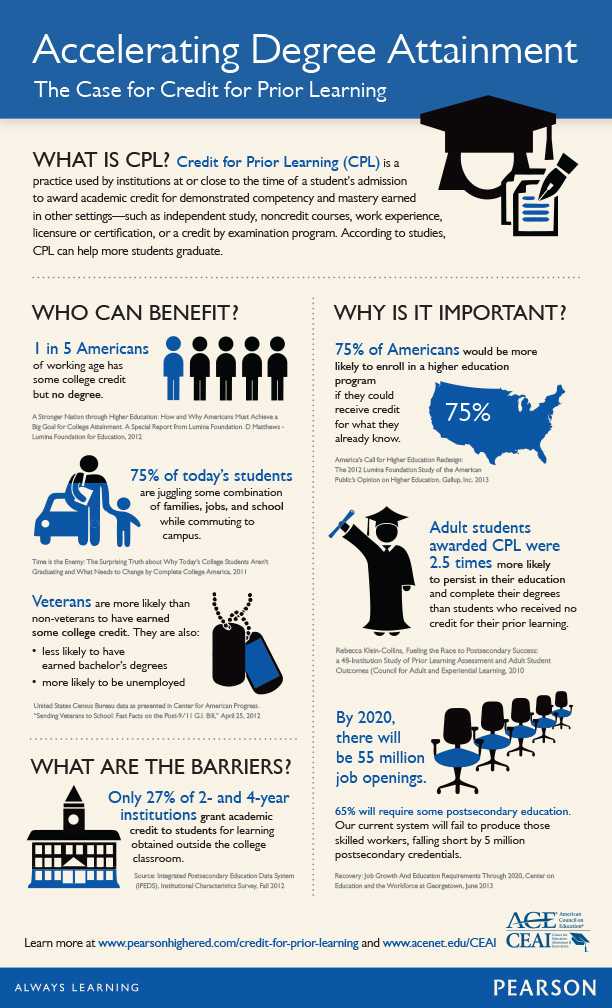How extending Credit for Prior Learning can accelerate college completion and improve employability.
 The face of the “average” college student is changing. Seventy-five percent of today’s students (mostly adult learners) are juggling some combination of family commitment, job, and education, while commuting to campus, according to Complete College America.1 Growing demands placed on working adult learners can make higher education seem unattainable, inflexible, and unrealistic. For too many people today, time is the barrier to college completion.
The face of the “average” college student is changing. Seventy-five percent of today’s students (mostly adult learners) are juggling some combination of family commitment, job, and education, while commuting to campus, according to Complete College America.1 Growing demands placed on working adult learners can make higher education seem unattainable, inflexible, and unrealistic. For too many people today, time is the barrier to college completion.
Making the case for CPL to help employment and the economy
The 2009 unemployment rate of high school graduates 25 and older was 9.7 percent, compared with 4.6 percent for college graduates.2 Moreover, by 2020, our economy will have jobs for nearly 165 million people —65 percent of which will require postsecondary training.
However, at our current production rate of graduates, the U.S. will fall short by five million workers with the necessary education and training to meet the skill profiles of the jobs likely to be created.3
Credit for Prior Learning has emerged as an effective pathway to help more learners today, with busy lifestyles, to achieve their higher education goals.
Credit for Prior Learning (CPL) is a term educators use to describe learning that a student acquires outside of a traditional academic environment. This learning may have been attained through work experience, professional development courses, military training or experience, independent study, noncredit courses, volunteer or community service, travel, non-college courses, or seminars, many of which are offered online, such as MOOCs.
CPL is also similar to Prior Learning Assessment (PLA)—the process by which an individual’s experiential and other extra-institutional learning is assessed and evaluated for the purposes of granting college credit, certification, or advanced standing toward further education or training. CPL is a practice used by institutions at or close to the time of a student’s admission, to award institutional credit for demonstrated competency mastery earned in other settings.
(Next page: Specifics on how the CPL model works for students and institutions)
At least some form of credit for prior learning has been in place since after World War I, when veterans first gained the opportunity to demonstrate their skills and knowledge through competency-based exams for high school equivalency. By the mid-1970’s, many institutions had implemented transfer policy and practice for military training, national examinations, and individualized assessments, such as the portfolio, with nationally recognized standards to guide the range of assessment options.
But CPL doesn’t have to apply specifically to veterans. When applied as part of a well-designed degree plan, CPL can increase student retention, encourage persistence, shorten time to completion, and translates valuable learning experiences into tangible progress towards education and career goals for all many students.
Benefits of the CPL Model
For students:
Motivation to Persist: Adult students who received PLAs credit were 2.5 times more likely to persist in their education and complete their degrees than students who received no credit for prior learning. More than half of PLA participants earned a degree within seven years, compared to 21 percent of non-PLA students.4
Accelerated Pathways: The acceptance of CPL offers an accelerated path to degrees that are relevant to the 21st century, and grounded in real experience for adult learners. This model offers a proven pathway to raise productivity in higher education and, to enable millions of students who have stopped short of a degree to complete their education.
Flexibility: The acceptance of CPL can open up a world of opportunity to students, breaking down traditional barriers to information, and helping them take advantage of free educational resources, such as MOOCs; competency-based degree programs; badging, and other learning opportunities now available in this new world of online and blended learning that is rapidly transforming higher education.
For institutions:
Meeting Demand: Non-traditional students account for nearly 40 percent of all U.S. 5 undergraduate enrollments. By instituting CPL, institutions are able to meet educational demands of this increasing student population.
Accelerating Degree Attainment: State legislatures have realized the efficacy of this model and have become involved with the implementation of applying CPL, thanks in part to advocacy by organizations such as the Lumina Foundation and Complete College America. The Obama Administration has also helped to encourage PLAs, most notably through a $2 billion Labor Department grant package aimed at job training for displaced workers.
For employers:
Employability: Currently, the nation faces the challenge of having a skills and training gap that contributes to lower employment rates. Applying CPL allows colleges and universities to produce more employable graduates with skills that are in demand by today’s workforce.
Meeting Unfulfilled Workforce Demands: Our current education and workforce training system will fail to produce enough skilled workers, falling short by three million associate or bachelor’s degrees, and almost five million post-secondary credentials. This means that important jobs will go unfilled, because employers can’t find workers with the right skills to fill them. CPL has the potential to produce more graduates.6
Cost-Effectiveness: Collectively, the U.S. spends approximately $772 billion annually on postsecondary-level education and training, and the bulk of this spending supports education and training occurring outside of formal education institutions. Because PLAs decrease time to graduation, fewer costs are incurred for students. CAEL estimates that students who hold PLA credits can save from $1,605-$6,000 over the course of their schooling, depending on the type of institution they attend and how much credit they have earned.7
(Next page: Infographic and CPL’s overall potential)
Overall, awarding institutional credit for prior learning has the potential to accelerate degree completion for students, at a lower cost, by providing increased access and flexibility for students who most need it.
The increased use of CPL will enable institutions to meet current educational demands, recognizing the rise of the “nontraditional” student and the importance of their role in fueling the economy. Employers will benefit by having a workforce with an educational pathway grounded in real experience, making for better prepared and more productive employees.
Infographic
1 Complete College America. Time is the Enemy: The Completion Shortfall, 2011 National Report. (September 2011).
2 National Center for Education Statistics. Digest of Education Statistics, 2010 (U.S. Department of Education, 2012).
3 Anthony P. Carnevale, Nicole Smith, Jeff Strohl. Recovery: Job Growth and Education Requirements through 2020. (www.georgetown.edu, June 2013).
4 10 Klein-Collins, R. Fueling the Race to Postsecondary Success: A 48-Institution Study of Prior Learning Assessment and Adult Student Outcomes. (The Council for Adult & Experiential Learning, 2010).
5 National Center for Education Statistics. Digest of Education Statistics, 2011 (U.S. Department of Education, 2012)
6 Anthony P. Carnevale, Nicole Smith, Jeff Strohl. Recovery: Job Growth and Education Requirements through 2020. (www.georgetown.edu, June 2013)
7 Klein-Collins, R. Underserved Students Who Earn Credit Through Prior Learning Assessment (PLA) Have Higher Degree Completion Rates and Shorter Time-to-Degree. Research Brief (The Council for Adult & Experiential Learning, April 2011).
Todd Hitchcock is SVP for Pearson Online Learning Services. Mary Beth Lakin is director of College and University Partnerships at the American Council on Education (ACE).
- 25 education trends for 2018 - January 1, 2018
- IT #1: 6 essential technologies on the higher ed horizon - December 27, 2017
- #3: 3 big ways today’s college students are different from just a decade ago - December 27, 2017

